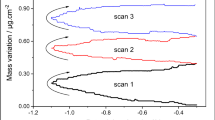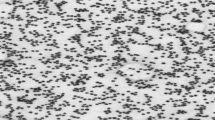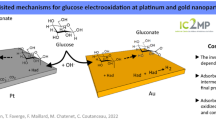Abstract
The kinetics of methylamine oxidation at a gold electrode in contact with an alkaline electrolyte solution was studied. The adsorptive behaviour of substrate molecules was determined by changes in the differential capacitance of the double layer at the electrode/solution interface. The electrooxidation of methylamine occurs only in the potential range of gold oxide layer formation. The general reaction pathways of methylamine oxidation on the gold electrode is proposed.
Similar content being viewed by others
Explore related subjects
Discover the latest articles, news and stories from top researchers in related subjects.Avoid common mistakes on your manuscript.
1 Introduction
Aliphatic amines are widely used as starting or intermediate agents in the production of various chemical compounds such as polymers, corrosion inhibitors, pesticides as well as pharmaceuticals. In spite of the unquestionable significance of aliphatic amines in industrial, clinical and environmental applications [1] their electrooxidation has been scarcely examined. Among electrocatalysts for oxidation of aliphatic organic compounds the most active is platinum in acidic solution and gold in alkaline medium [2–7]. For the platinum electrode Horányi and Rizmayer [8, 9] have concluded that the oxidation of methylamine and butylamine both in acidic and alkaline medium produces adsorbed cyanide species. This conclusion has been confirmed by results obtained by Huerta et al. [10, 11] on monocrystalline Pt electrodes. A dual mechanism depending on the electrode potential has been proposed by Mann et al. [12, 13] for the oxidation of aliphatic amines in acetonitrilic solution. Studies on gold have been limited only to the anodic oxidation of ethylamine in aqueous alkaline media. The results obtained by Johnson et al. [14–16] and Luo et al. [17] have shown that the oxidation of ethylamine on gold occurs concomitantly with the formation of a AuO surface layer. The exact mechanism of aliphatic amine electrooxidation has not been sufficiently clearly described yet, and more work is needed.
In this study the oxidation of methylamine on a gold electrode in an alkaline supporting electrolyte solution was investigated. Additional information about adsorption of the molecules under investigation was obtained from the differential capacitance of the electric double layer versus potential measurements.
2 Experimental
Cyclic voltammetric and differential capacitance studies were performed in a conventional three-compartment cell separated by glass frits using a gold bead (99.999% purity) of 0.3 cm2 geometric area as working electrode and a gold sheet as counter electrode. A hydrogen electrode (RHE) in the supporting electrolyte was used as reference. For comparison with published data all potentials are quoted versus the saturated calomel electrode (SCE).
The experimental setup used to record cyclic voltammograms (j–E curves) and differential capacitance of the electric double layer versus electrode potential curves (C–E) was described earlier [18]. The C–E curves were obtained by superimposing ac sinusoidal voltage signal (15 s−1, 5 mV) on a slow linear electrode potential scan (dE/dt = 0.005 V s−1). A slower scan rate of 0.002 V s−1 did not affect the observed C–E curves. The equilibrium of adsorption/desorption was checked in experiments at different frequencies. For frequencies in the range from 5 s−1 to 40 s−1 no frequency dispersion of the differential capacity was observed in the potential range between E = −1.0 V and E = 0.1 V versus SCE, in the supporting electrolyte solution and between E = −0.4 V and E = 0.1 V in solution containing amine of concentrations between 0.00005 mol dm−3 and 0.1 mol dm−3. Stirring had no effect on the course of the C–E curves, which indicated that mass transport did not limit the rate of adsorption/desorption of amine at the bulk concentrations studied. These findings confirm that the differential capacity data in the above mentioned potential range can be considered at equilibrium.
Prior to each series of measurements with amines, the working electrode was electrochemically activated by cycling (dE/dt=0.1 V s−1) in the potential range between E = −1.1 V and E = 0.1 V versus SCE in supporting electrolyte (0.1 mol dm−3 NaOH), where no electrochemical reactions occur on the gold surface. This procedure avoids structural changes at the gold surface. At the end of each series of experiments with amine, the gold electrode was rinsed with water and the j–E and C–E curves were re-recorded in fresh supporting electrolyte. The shapes of the j–E and C–E curves in each series of experiments were the same as those taken before the measurements. This means that the surface of the working electrode had not changed during the experiment.
The solutions were prepared using water purified in a Millipore Milli-Q system, methylamine of Aldrich analytical grade quality and NaOH of Merck analytical grade quality. All solutions under investigation were purged with high purity argon. The measurements were performed at 295 K.
3 Results and discussion
The set of representative cyclic voltammograms recorded at the gold electrode in the supporting electrolyte solution, 0.1 mol dm−3 NaOH, and in the presence of methylamine of increased concentrations is presented in Fig. 1. A well-defined anodic peak at E = 0.3 V versus SCE and a cathodic peak at E = 0.08 versus SCE visible in the j–E curve of the bare electrode (curve 1) can be assigned, according to Newman and Burstein [19], to gold oxide formation and to its reduction, respectively.
From Fig. 1 it is clear that methylamine is inactive on gold at low electrode potentials (curves 2–4) and its oxidation starts at a potential above E > 0.2 V versus SCE and proceeds irreversibly in parallel with gold oxide formation. Similar behaviour was observed in the case of methanol oxidation on polycrystalline gold [20, 21]. When comparing the response of the gold electrode recorded in the supporting electrolyte solution (curve 1, Fig. 1) with those obtained in the presence of amine it was found that the charge used for reduction of gold oxide in the presence of amine is smaller then that consumed in the solution without the solute. This observation points to participation of the gold oxide in the oxidation of amine.
A characteristic feature is an enhancement in the anodic current (j) and some shift of the cathodic peaks negatively with increasing amine concentration (c A) in solution. At the same time the maxima in the oxidation peaks shift positively. Such a shift is typical of reaction involving adsorbed molecules on the electrode surface. An increase in the amine coverage may generate a decrease in gold oxide coverage. This conclusion is supported by the fact that any increase in the anodic peak is accompanied by a decrease in the cathodic peak.
Some insight into the mechanism of methylamine oxidation was possible using Tafel analysis. The j–E relationships for a few chosen amine concentrations plotted in log j–E coordinates give straight lines in the potential range 0.25–0.375 V versus SCE, (Fig. 2). The value of the Tafel slope, dE/dlog j = 2.303RT/α nF, is 0.20 ± 0.02 V per decade for the lowest organic compound concentration and increases somewhat with increasing amine content. Moreover, the log j versus E curves are independent of pH in the range 11–13.7 (Fig. 3). The average Tafel slope values higher than 0.12 V decade−1 support the assumption of an adsorption step preceding the first electron transfer determining the overall reaction rate (rds). Further steps proceed so fast that they have no influence on the rate of methylamine oxidation. In the case of the simple rds involving the first electron transfer with no contribution of adsorption, a slope of only 0.12 V decade−1 should be found [22]. The above finding is in agreement with the value of the electron transfer coefficient αn = 0.30 ± 0.02 which decreased with increase in methylamine concentration. The conclusion about oxidation of adsorbed amine molecules is in accordance with the observation that the current density did not decrease under stirring by bubbling with inert gas.
The decisive role of adsorption in the kinetics of methylamine electrooxidation on gold is indicated by the fractional reaction order with respect to the substrate concentration, z A. Figure 4 displays the plots of the logarithm of current density versus the logarithm of substrate and supporting electrolyte concentration at constant electrode potentials, 0.3 V versus SCE. The slopes of the straight lines of the appropriate log j-logc A relationships give the reaction order with respect to the substrate concentration, z A = dj/dc A and to the hydroxyl anion concentration, \( z_{{\hbox{OH}}^{\hbox{-}} } = {\hbox{d}}j/{\hbox{d}}c_{{\hbox{OH}}^{\hbox{-}} }\), respectively. The resulting z A is 0.30 ± 0.01 for c A ≤ 0.001 mol dm−3 whereas \( z_{{\hbox{OH}}^{\hbox{-}} }\) is 0.35 ± 0.01 for c -OH ≤ 0.002 mol dm−3. An increase in the surface coverage by the absorbed species is most probably the reason for a decrease in the reaction order for the amine concentration over 0.001 mol dm−3, (see Fig. 4).
In order to obtain further insight into the mechanism of methylamine oxidation, the voltammograms were recorded at various sweep rates. A characteristic feature is the shift of the potential of the peak oxidation towards more positive values with increasing sweep rate, confirming the irreversibility of the electrocatalytic process. The log j P versus log v plots, (Fig. 5) are linear with the resulting slope of \({\hbox{d}}\log j_{\hbox{p}} /{\hbox{d}}\log v\)in the proximity 0.75. The magnitude of this parameter means that the mechanism of methylamine oxidation on gold is not pure from the kinetic point of view and may indicate a mixed, i.e., diffusion–adsorption rate control. For a pure adsorption process the value of the \({\hbox{d}}\log j_{\hbox{p}} /{\hbox{d}}\log v\) slope should be 1, while for a pure diffusion controlled process it should be 0.5.
Adsorption of the amine preceding its oxidation can be supported further by the results of differential capacitance of the electrical double layer versus potential measurements. A representative set of C–E curves depicted in Fig. 6 illustrates changes in the differential capacitance of the double layer as a function of electrode potential, in 0.1 mol dm−3 NaOH electrolyte and at various methylamine concentrations.
Differential capacitance-potential curves recorded on the gold electrode in 0.1 mol dm−3 NaOH (curve 1) and with increased methylamine concentration: (2) 0.00005 mol dm−3; (3) 0.0001 mol dm−3; (4) 0.0005 mol dm−3; (5) 0.001 mol dm−3; (6) 0.002 mol dm−3; (7) 0.005 mol dm−3; (8) 0.05 mol dm−3; (9) 0.1 mol dm−3. dE/dt = 0.005 V s−1
A gradual suppression of the C–E curves with increasing amine bulk concentration takes place both in the potential range of the characteristic minimum in the vicinity of the potential of zero charge (E pzc) and of the adsorption/desorption maximum on the negatively charged electrode surface. This observation gives clear evidence for the substitution of water with organic substrate at the gold surface. The methylamine molecule is able to form a surface complex by the coordinative interaction between the electrode surface and the electron lone pair localized at the nitrogen atom. Relatively strong adsorption of amine at the electrode/solution interface is manifested by the fact that the C–E curves for the highest solute concentration at E < −1.0 V versus SCE do not coincide with the corresponding C–E curve of the supporting electrolyte. This implies that some adsorbate molecules remain at the electrode surface.
It should be noted that the potential range in which methylamine molecules are adsorbed on the gold/alkaline solution interface coincides with that in which the adsorption of hydroxyl ions occurs [20, 23–25]. Thus a quantitative evaluation of the C–E curves is not possible because of the competing adsorption of amine and hydroxyl ions on the electrode. The differential capacitance measurements with a non-adsorbing supporting electrolyte solution, 0.02 mol dm−3 NaClO4, [26] have been discussed elsewhere [27]. A comparison of the data in Fig. 6 with those obtained earlier in a neutral medium (see Fig. 1 in [27]) reveals that the potential range of amine adsorption as measured with respect to E pzc does not change with electrolyte pH. Very strong interaction between the methylamine molecule and the electrode surface is suggested by the standard Gibbs energy of adsorption, \( \Delta G_{{\hbox{ad}}} ^0 \)= −30.46 kJ mol−1 [27], which is considerably higher when compared with those obtained for other aliphatic compounds adsorbed on gold. There are no data on \( \Delta G_{{\hbox{ad}}} ^0 \) for methanol adsorption on gold, but for example \( \Delta G_{{\hbox{ad}}} ^0 \) determined for n-propanol reaches only about −5 kJ mol−1 [28].
4 Conclusion
From the kinetic and differential capacitance results it is evident that amine molecules adsorb on the gold electrode surface in the range of potentials preceding the electrooxidation process. The process considered always occurs only in the potential range of gold oxide layer formation. The general reaction pathways of methylamine oxidation on the gold electrode in alkaline solution can be formulated as follows: 
The possible reaction pathways involve the first electron transfer connected with the oxidation of the hydrogen atom abstracted from the amine group of an adsorbed molecule as the reaction determining step. Methylamine oxidation proceeds via imine and next to aldehyde and ammonium after hydrolysis of imine. The gold surface does not change during both voltammetric and differential capacitance measurements. This shows that cyanides are not formed on the gold surface. This agrees with the commonly known fact that on gold the dissociative chemisorption of molecules of organic compounds does not occur, in contrast to platinum [8–11].
References
Morrison RT, Boyd RN (1985) Organic chemistry. PWN, Warsaw, p 822
Bełtowska-Brzezinska M (1977) Electrochim Acta 22:1313
Hauffe W, Heitbaum J (1978) Electrochim Acta 23:299
Bełtowska-Brzezinska M (1979) Electrochim Acta 24:409
Bełtowska-Brzezinska M (1980) Electrochim Acta 25:267
Bełtowska-Brzezinska M (1980) Kinetics and mechanism of electrocatalytic oxidation of alcohols on gold, platinum and gold-platinum alloys, edited by UAM Press, Poznań
Bełtowska-Brzezinska M, Łuczak T, Holze R (1997) J Appl Electrochem 27:999
Horányi G, Rizmayer EM (1988) J Electroanal Chem 251:403
Horányi G, Rizmayer EM (1989) J Electroanal Chem 264:273
Huerta F, Morallón E, Quijada C, Vázquez JL, Pérez JM, Aldaz A (1999) J Electroanal Chem 467:105
Huerta F, Morallón E, Pérez JM, Vázquez JL, Aldaz A (1999) J Electroanal Chem 469:159
Mann CK (1964) Anal Chem 36:2424
Barnes KK, Mann CK (1967) J Org Chem 32:1474
Jackson WA, LaCourse WR, Dobberpuhl AD, Johnson DC (1991) Electroanalysis 3:607
Dobberpuhl AD, Johnson DC (1995) Anal Chem 67:1254
Dobberpuhl AD, Johnson DC (1996) Electroanalysis 8(9):726
Luo P, Zhang F, Baldwin RP (1991) Anal Chim Acta 244:169
Holze R, Bełtowska-Brzezinska M, Łuczak T (1990) Electrochim Acta 35:1345
Newman RC, Burstein GT (1981) J Electroanal Chem 129:343
Avramov-Ivić M, Jovanović V, Vlajnić G, Popić J (1997) J Electroanal Chem 423:119
Borkowska Z, Tymosiak-Zielińska A, Shul G (2004) Electrochim Acta 49:1209
Kisza A (2001) Electrochemistry II. WNT, Warsaw. p 94
Holze R, Bełtowska-Brzezinska M (1986) J Electroanal Chem 201:387
Ocon P, Alonso C, Celdran R, Gonzales-Velasko J (1986) J Electroanal Chem 206:179
Desilvestro J, Weaver MJ (1986) J Electroanal Chem 209:377
Clavilier J, Nguyen C, Van Huong (1977) J Electroanal Chem 80:101
Łuczak T (2006) Coll Surf A 280:125
Bełtowska-Brzezinska M, Łuczak T, Holze R (1998) Surf Sci 418:281
Acknowledgement
Financial support of this work by the Ministry of Scientific Research and Information Technology, Poland is gratefully acknowledged. The author thanks Professor M. Bełtowska-Brzezinska for valuable discussion.
Author information
Authors and Affiliations
Corresponding author
Rights and permissions
About this article
Cite this article
Łuczak, T. Activity of gold towards methylamine electrooxidation. J Appl Electrochem 37, 461–466 (2007). https://doi.org/10.1007/s10800-006-9276-y
Received:
Accepted:
Published:
Issue Date:
DOI: https://doi.org/10.1007/s10800-006-9276-y










